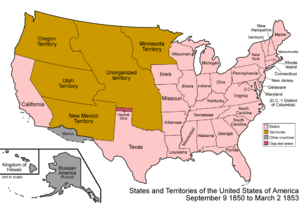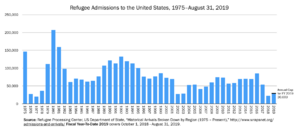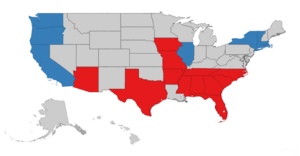Immigration policy in Texas facts for kids
The state of Texas has a long history with people moving in and out, and rules about who can come. Long ago, Native American tribes lived here. Then, in the 1600s, Europeans from France and Spain arrived and claimed the land. In the 1820s, the Mexican government offered reasons for people to move to Mexican Texas, especially from the southern United States. Many people, including those who were not allowed to come after 1830, continued to move there.
Later, in the 1980s, more people came to Texas. This was partly because of a new law called the Immigration Reform and Control Act and a booming oil industry. By 2018, almost five million immigrants lived in Texas.
Immigration is a big topic in American politics. Even though fewer people are moving to the U.S. now, recent rules have tried to limit immigration to Texas and reduce protections for migrants. The U.S. federal government controls the international border and makes most immigration laws. State and local governments can decide if they want to help enforce these laws and what services they offer to immigrants.
Contents
Texas's Story of Immigration
A Quick Look at Texas History
Before Texas was a state, many Native American tribes lived there. The Caddo, Lipan Apache, Karankawa, Jumano, Tonkawa, and Coahuiltecan people were some of the first. In the 1600s, the French and Spanish began to settle the land. European explorers and missionaries greatly changed the lives of Native Americans. The Spanish claimed the most land. Their culture still strongly influences Texas today.
In 1820, Mexico, which included what is now Texas, became independent from Spain. Many people from the southern United States moved to Texas, sometimes legally and sometimes not. This caused problems. In 1836, Texas declared independence from Mexico and became the Republic of Texas. In 1846, the United States added Texas, mainly to continue slavery. Because of this, many Mexican Americans found themselves living in a new country without moving. A popular saying among them is, "We didn't cross the border, the border crossed us." The current border of Texas was set in 1850.
Understanding Immigration
Immigration has always been a big topic in the United States. It has become more divided in the last 20 years. The federal government of the United States makes most immigration rules. These rules decide who can become a new citizen or live in the country temporarily. However, states can make their own rules. They can decide what public services immigrants can use. They can also set rules for checking employees. Some places in Texas have chosen not to fully cooperate with federal immigration enforcement. These are sometimes called sanctuary jurisdictions. Once immigrants are legally in the U.S., they can move freely between states. They can work anywhere if they have federal permission.
Before 1970, Texas mostly attracted people who already lived in the United States. Immigrants from Mexico would often pass through Texas but not stay. The number of foreign-born people in Texas was about 3%. But in the 1980s, immigration to Texas changed a lot. The state had an economic boom in the oil industry. This led more people to settle there, especially immigrants from Mexico. The foreign-born population grew to almost 10% by the end of the 1980s.
The Immigration Reform and Control Act (IRCA) in 1986 also encouraged immigrants to settle in Texas. This law made it harder to hire immigrants who were not authorized to work. But it also made many immigrants who were living in the U.S. without authorization legal residents. Many of these immigrants settled in Texas. By 2010, almost 17% of Texas's population was foreign-born.
As of 2018, Texas is home to about 4.7 million immigrants. Most of them are from Mexico. Texas has the second-largest immigrant population in the United States. It also has the second-highest number of Mexican immigrants. The American Immigration Council says that one out of every six Texans is an immigrant. Also, 15% of Texans born in the U.S. have at least one parent who is an immigrant. In 2015, over a third of all immigrants in Texas had become U.S. citizens.
Recently, the number of immigrants coming to the U.S. has grown more slowly. More new immigrants are from Asia and have more education. The Mexican immigrant population has decreased by half a million people since 2010. In 2018, Canada welcomed more refugees than the United States.
Past Rules and Policies
Sanctuary Cities
A sanctuary city is a place that tries to limit how much it helps the federal government enforce immigration laws. These policies aim to reduce fears of deportation (being sent out of the country) and families being separated. For example, local police might not hold people for federal immigration officers. Many cities in Texas were considered sanctuary cities. However, a state law called Texas Senate Bill 4 later banned them.
Border Tent Courts
President Trump set up special tent courts in border towns like Brownsville and Laredo in September 2019. These courts were meant to quickly process the many migrants waiting for a hearing. People waiting in Mexico had shorter trips to these courts. Immigration judges in San Antonio could attend hearings online. There were protests about how secret these courts were. The Homeland Security did not let reporters or the public inside until January 2020. Some also worried that people were not getting fair trials in these tent courts.
Current Rules and Policies
Senate Bill 4
On May 7, 2017, Governor Greg Abbott signed a law. This law allowed police officers to ask about a person's immigration status if they were arrested. The law also banned sanctuary cities in Texas. It required local police to help the federal government with immigration enforcement. On August 30, 2017, a judge temporarily stopped the law. This was so several lawsuits could be decided. However, Texas appealed this decision. On September 25, 2017, another court allowed Senate Bill 4 to go into effect. On March 13, 2018, the court made an exception. It said that officials could not be punished for publicly supporting sanctuary city policies.
Ongoing Rules and Policies
Helping Refugees Settle
On January 10, 2020, Governor Greg Abbott announced that Texas would not accept any refugees that year. This made Texas the first state to do so. This decision came after President Donald Trump allowed local governments to stop refugee resettlements in September 2019. Governor Abbott said Texas had received more refugees than any other state. He stated that 10% of all refugees in the U.S. had settled in Texas over the past 10 years. On January 15, 2020, a federal judge blocked this order. The judge ruled that states cannot deny refugees entry. The judge also said it was not good for the public. So, Texas continues to accept refugees.
Asylum Law
Under U.S. federal law, a person seeking asylum must show they fear harm in their home country. This harm must be based on their race, religion, nationality, political views, or social group. On January 25, 2018, President Trump started the Migrant Protection Protocols. This was also known as the "Remain in Mexico" Program. It sent asylum seekers in the United States back to Mexico while they waited for their hearing. Seven border crossings used this program. Four of them are in Texas: El Paso-Ciudad Juárez, Brownsville-Matamoros, Laredo-Nuevo Laredo, and Eagle Pass-Piedras Negras. On March 4, 2020, a court stopped the program in Arizona and California. It ruled that the program broke U.S. law. However, the law stayed in effect at the four Texas crossings. On March 11, 2020, the Supreme Court temporarily allowed the "Remain in Mexico" program to continue. A final decision on this program is still pending as of March 2020.




